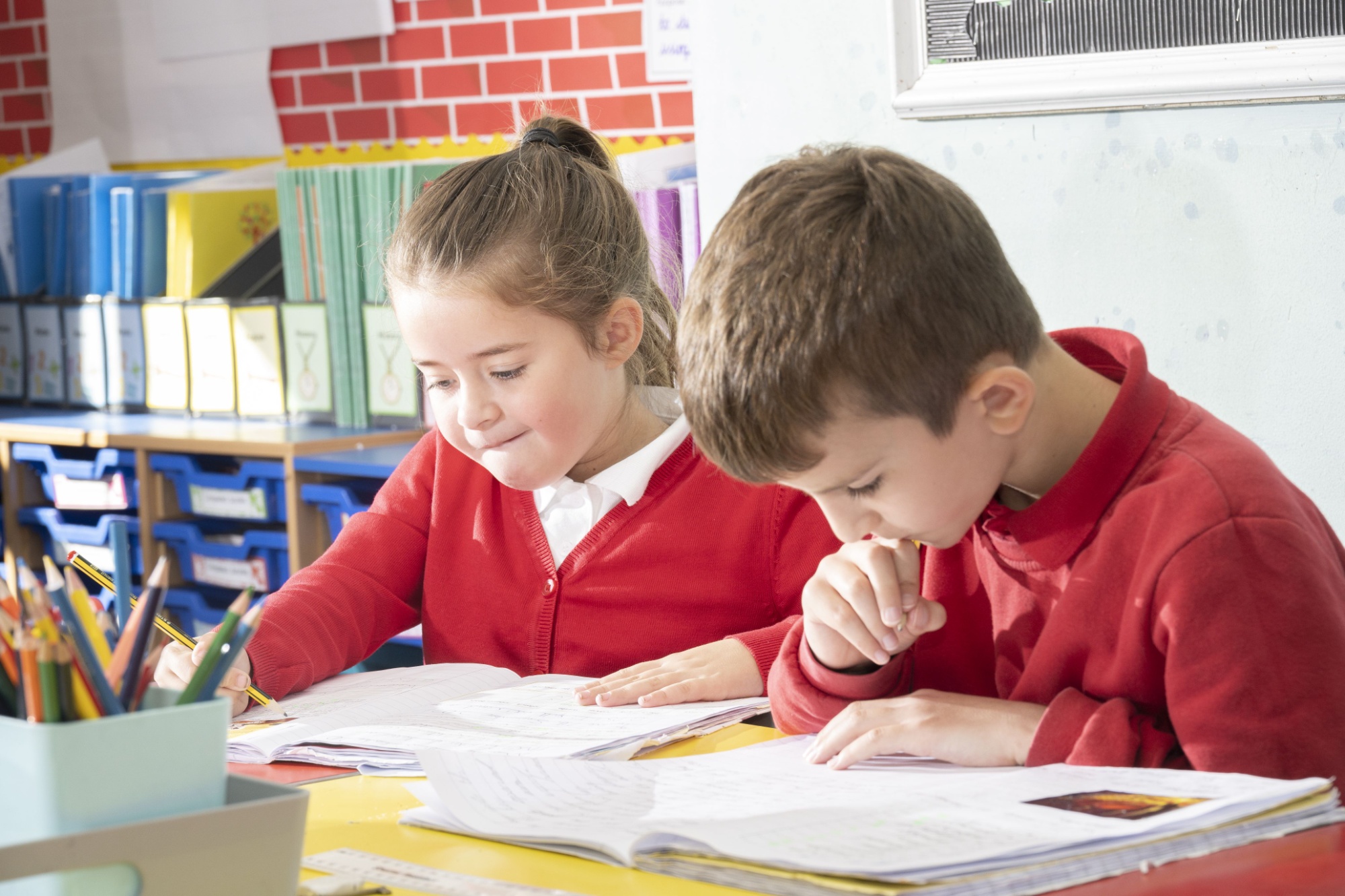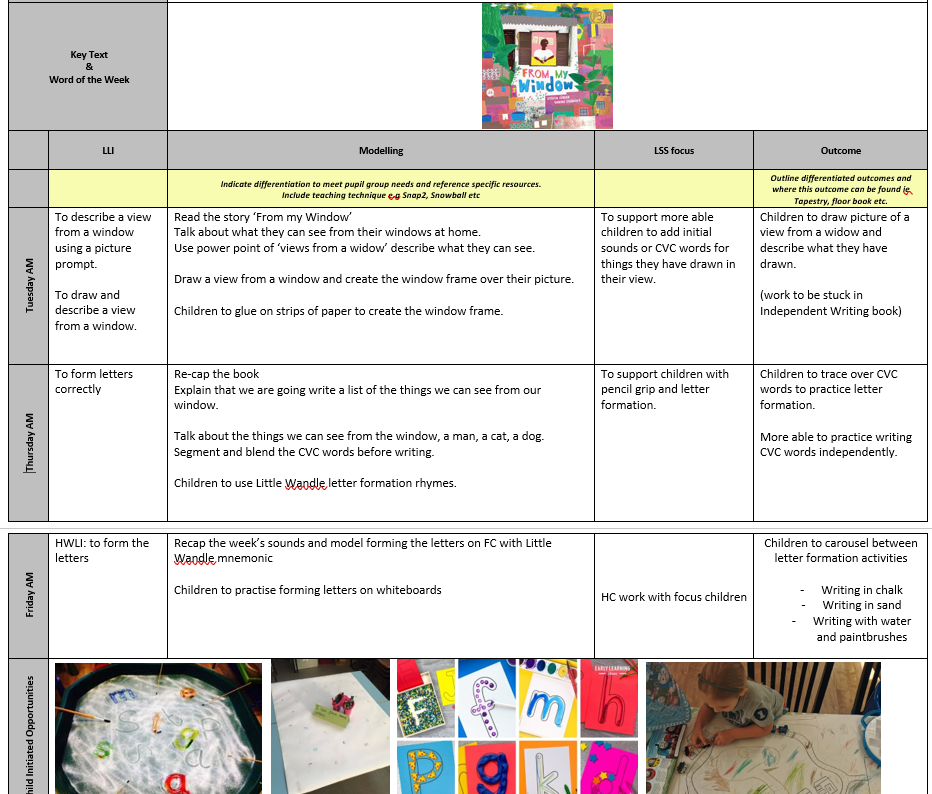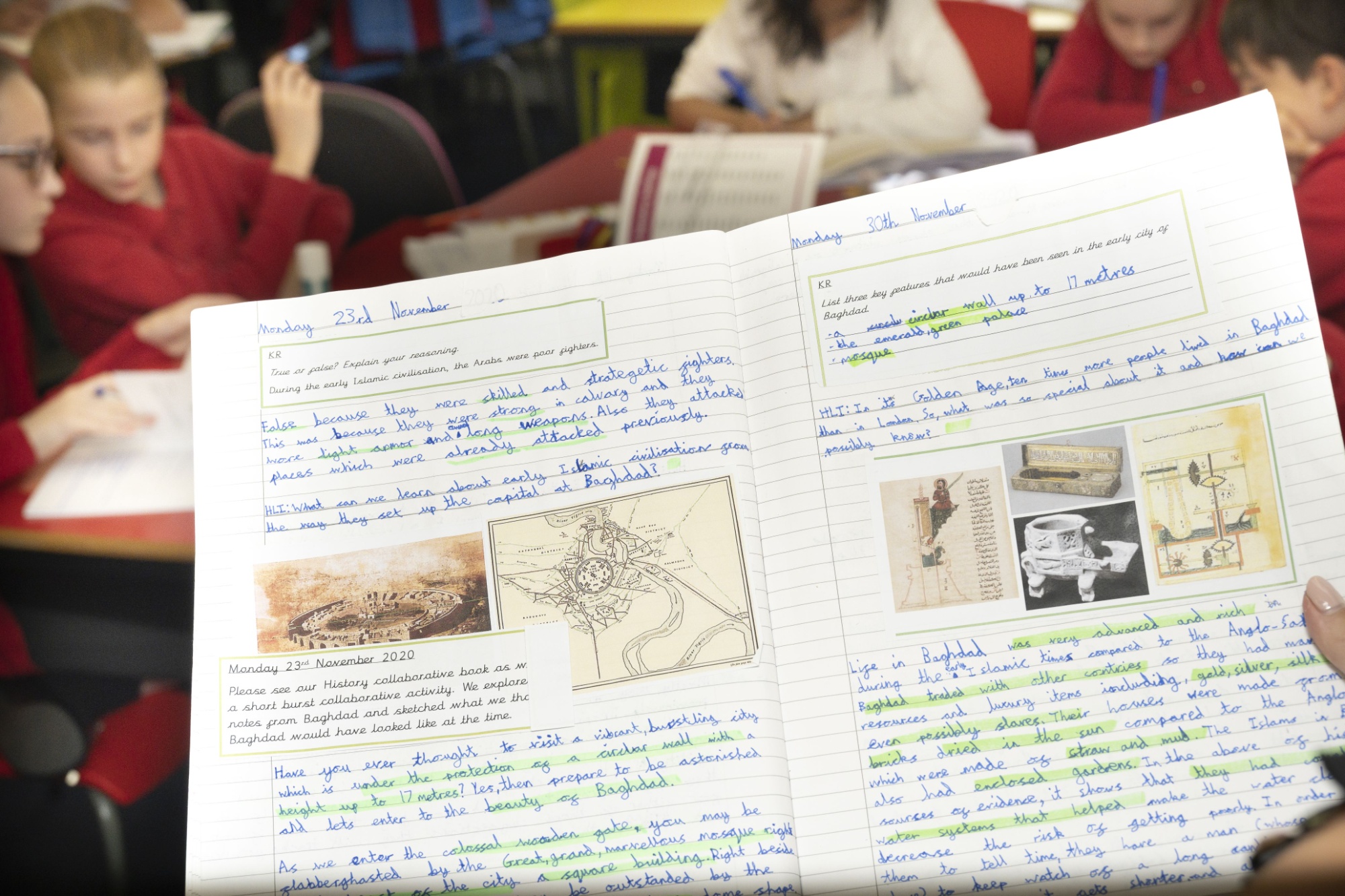English
Vision and intent for English
At Temple Meadow, we deliver a high-quality English curriculum that gives children the best opportunity to become confident, literate, successful members of society, with a deep love and understanding of English language and literature. The development of Literacy knowledge and skills is key to improving a child's life chances. Teachers have high expectations for all children to achieve and enjoy English and to be able to use the skills and knowledge they have acquired in a range of contexts, and throughout the wider curriculum. We strive to ensure all children can communicate clearly, in a range of forms, and become masters of language.
Cultural capital considerations for English
Given our context linked to high levels of deprivation, we are aware of the high need to support the development of Temple Meadow pupils’ English capital. This is key to their future success in their next stage of education and in future life. We plan to ensure that the experiences we provide through our English curriculum and by connecting learning across subjects, gives them confidence and the capacity to succeed in the future and to support a long-term aspiration of all U.K. pupils achieving in society.
National Curriculum coverage
The overarching aim for English in the National Curriculum is to promote high standards of language and literacy by equipping pupils with a strong command of the spoken and written word, and to develop their love of literature through widespread reading for enjoyment. The National Curriculum for English aims to ensure that all pupils:
- read easily, fluently and with good understanding
- develop the habit of reading widely and often, for both pleasure and information
- acquire a wide vocabulary, an understanding of grammar and knowledge of linguistic conventions for reading, writing and spoken language
- appreciate our rich and varied literary heritage
- write clearly, accurately and coherently, adapting their language and style in and for a range of contexts, purposes and audiences
- use discussion in order to learn; they should be able to elaborate and explain clearly their understanding and ideas
- are competent in the arts of speaking and listening, making formal presentations, demonstrating to others and participating in debate.
Teacher view of the importance of English
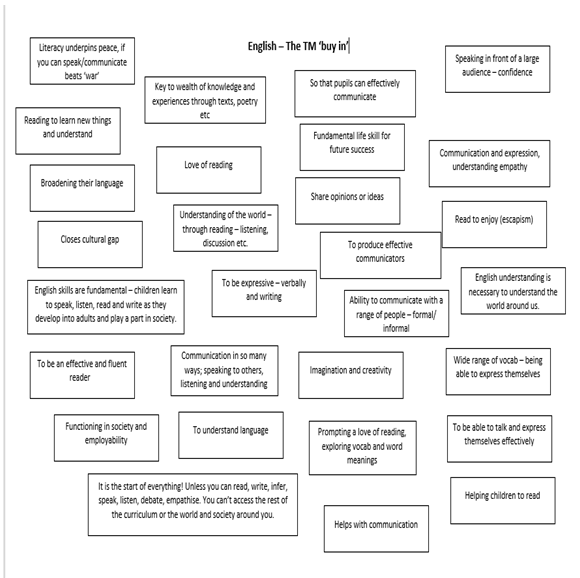
Implementation of English
English planning and resources
All English planning is captured into one proforma; this includes Reading and Writing learning journey outcomes (including 2 x GPS Knowledge Retrieval tasks and 2 x Handwriting practise sessions) and a daily spelling lesson. In Year 6, this also includes a weekly comprehension lesson.
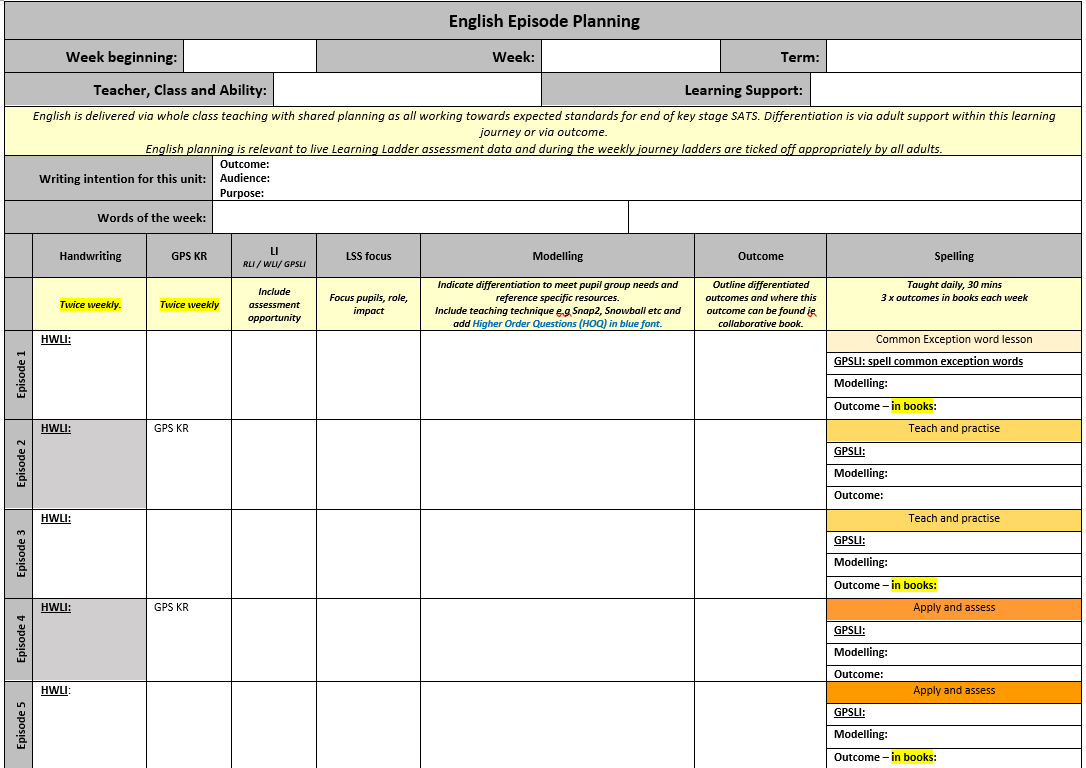
Reading and Writing
English is taught through our Irresistible Learning approach, which means that our, high quality, language rich texts are used to drive and deliver high quality Reading and Writing outcomes. These include fiction and non-fiction works, from a range of classic and contemporary authors.
The texts that we use have been specifically selected to meet the needs of each year group. These are located within the teacher resource cupboard in the dining hall.
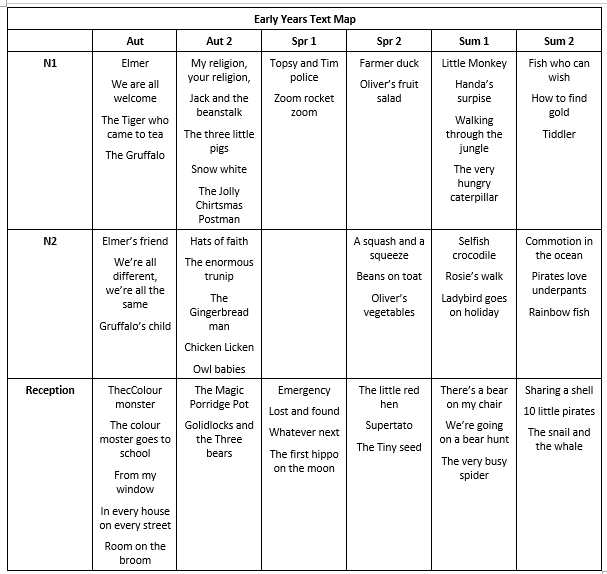
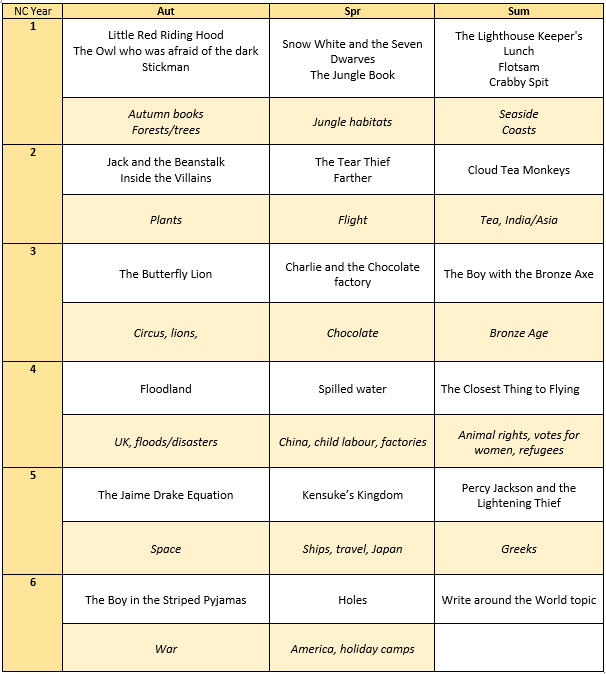
Book Maps
It is essential that teachers have fully read the text and have a solid understanding of the themes, language and opportunities that the text provides.
Teachers start by capturing the themes and story plot into a Book Map. This is designed to support the teachers thought process through the text but also acts as an aide for other adults working within these year groups.
While teachers are creating their book map, or on completion, they move onto creating their Medium-Term Plans.
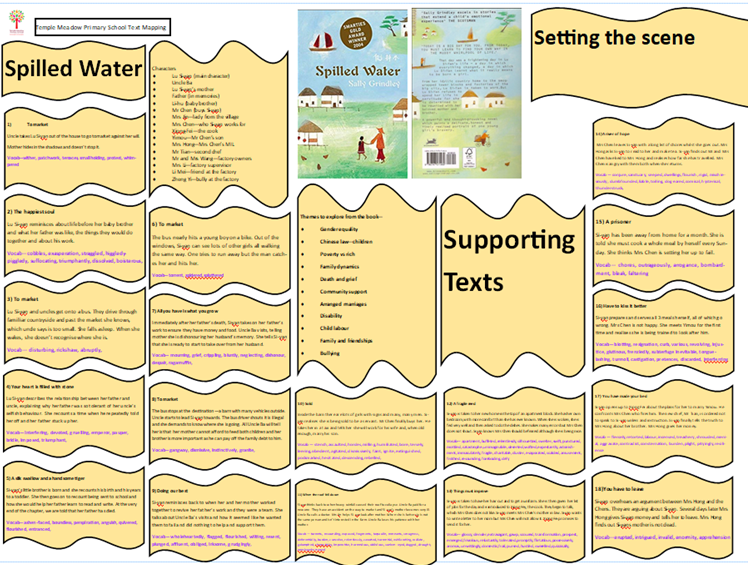
Medium Term Plans
The MTP outlines the English coverage across a term, detailing the reading, grammar, punctuation and spelling objectives that will be taught across the term. To show consolidation and progress, these are colour coded to identify where skills are new learning (black font) or consolidation (brown font). We place a key focus on widening our pupils’ vocabulary with a carefully chosen word of the week planned for that links to the intended outcome. We value writing for a purpose and our MTPs clearly outline the Writing outcome at the end of a unit, along with the audience.
The MTP has links to all other documents that teacher’s may need to refer to when planning and to support teacher’s subject knowledge. Our MTPs have been aligned to assure a wide genre coverage and clearly idenitfy progression within a genre.
In Year 1 Autumn term, the MTP does differ to the rest of the school; the curriculum has been designed to allow for mastery of vital grammar and punctuation skills and therefore extended writing outcomes have been removed. Spelling is also not included as Little Wandle phonics is delivered within Year 1.
Each term, the MTP is replaced and the process is repeated to reflect the new text. Over the year, teachers must ensure that they have covered the breadth of the National Curriculum, with particular emphasis on genre coverage, which is monitored by the Writing Lead. This approach allows Writing and Reading to seamlessly flow into one high quality learning journey.
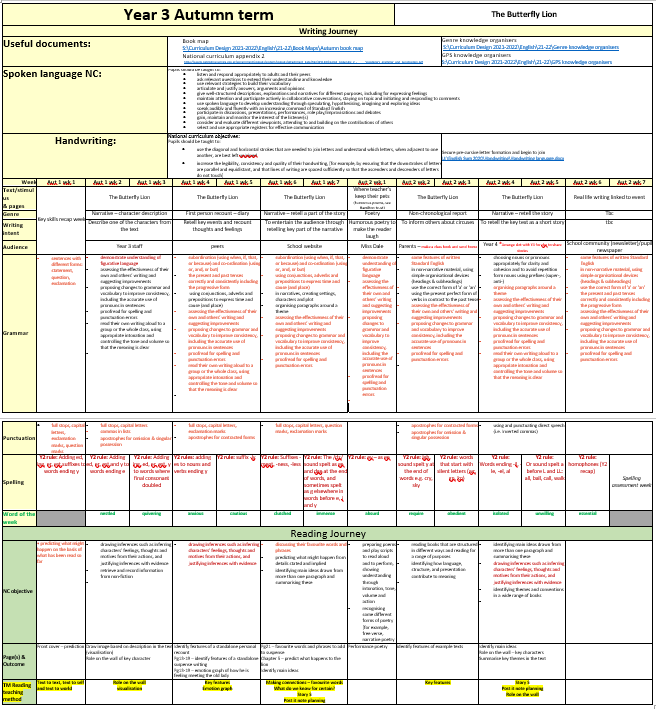
Writing
All English learning journey outcomes are captured into one English book, showcasing the entire learning journey - from the skills being taught, through to independent pieces of extended writing (which are completed at the end of each set of learning episodes). The frequency of these is dependent on the year group’s learning journey and the length of the composition that is being produced. For example, KS1 pupils are likely to produce an extended outcome weekly, whereas UKS2 would produce an extended outcome every 2-3 weeks. Extended writes are clear and easy to see within the learning journey as they are always completed on yellow paper.
Each outcome in the English book must have a clear date and LI (Learning Intention).
If the learning intention for the lesson is linked to a writing skill then the learning intention will be WLI:.
Over the course of an academic year, children in all year groups will write for different audiences and purposes. The full range of National Curriculum genres are covered in each year group. Examples of this are detailed below:
|
Year Group |
Fiction |
Non-Fiction |
Poetry |
|
Year 1* |
Simple stories with patterned language and predictable phrasing. Retell an event based on personal experiences. Retell a traditional story. |
Recounts of personal experiences. Labels, lists and captions. Simple non-chronological report Simple instructions, following a personal experience. Pictures and sentences to support a simple explanation. |
Read, write and perform free verse poetry. |
|
Year 2 |
Retell a traditional story. Write a story with a familiar character, theme or setting. Write a story based on a story/myth/culture from their topic.
|
Explanation – supported by pictures/diagrams. Recount of historical event. Recounts of personal experiences. Non-chronological report which describes and compares information. Series of instructions – can be fiction based. |
Read, write and perform free verse poetry and some structured poetry (e.g., calligrams). Personal response to poetry. |
|
Year 3 |
Write a new fable, to convey a moral. Write an adventure story, focusing on plot. Write and perform a play, based on a traditional story. Write a story from a key character’s perspective. |
Write a new/sports report on an ‘unfolding event’. Write and evaluate a range of instructions and directions. Write an explanation. Write a none chronological report, using a plan (e.g., spider gram). Persuasion - Present a point of view, in the form of a letter. |
Read, write and perform Tanka, Haiku, Kennings and Limericks. Personal responses to poetry. |
|
Year 4 |
Write a myth, focused on characterisation – descriptions and key dialogue, interwoven into action, (e.g., wanted poster, ‘lonely hearts’ column, job advertisement). Write ad perform a play, based on a familiar story. Write a narrative focusing on setting. Write an autobiographical story/account, relating to a theme from a familiar story. |
Write a non-chronological report, based on independently gathered notes. Persuasion – assemble a presentation, including visual aids (graphs/diagrams), supporting a particular view point. Discussion – consider two sides of an argument, summarise and relay a course of action in a letter. Write an explanation, in an impersonal style, (passive voice). |
Read, write and perform riddles and narrative poems. Personal responses to poetry. Recite familiar poems by heart. |
|
Year 5 |
Retell a traditional tale/familiar story from a different character’s perspective. Write narratives focusing on tension, atmosphere (through setting and plot) and creating suspense). Write a narrative in the style of a familiar author. Complete sections of familiar story, writing in the same style as the author. Plan and write a contemporary version of a familiar text.
|
Write a biographical account, based on research. Write a non-chronological report. Persuasion – adapt persuasive writing for different audiences and purposes, (e.g., a fund-raising event for ne P.E. equipment – a letter to the Head Teacher, a poster for the school website and a tweet to children). Write detail instructions, with a clear introduction and conclusion. Write an information leaflet, comparing two or more subjects. Write up a balanced discussion presenting two sides of an argument, following a debate. |
Read, write, perform and respond to cinquains and raps. Research a particular poet. Personal responses to poetry. Recite familiar poems by heart. |
|
Year 6 |
Write a range of short stories conveying different genres, (including ‘genre swap’ stories, where different sections are from different genres. Write a single extended narrative, or a variety of shorter ones, focusing on specific themes, (e.g., setting, |
Write a historical recount, in role, (e.g., recount of D-Day landings, as Winston Churchill). Explanation – present findings from an enquiry, including conclusions, relationships, and explanations of and degree of trust in results. Write a report as part of a presentation on a non-fiction subject. Choose appropriate style and form based on different audiences. Persuasion – construct an argument and present it to a class/classes, using standard English. Evaluate its success. Discussion – write up a debate which shows the opinions of multiple points of view. Debating skills – a series of live debates on various subjects. Work in pairs/groups/individually to prepare, present and write up various points and views. |
Read, write and perform monologues. Personal responses to poetry. Recite familiar poems |
At this stage, simple sentences make up the bulk of extended writing outcomes
Pupils should be taught to:
- develop positive attitudes towards and stamina for writing by writing narratives about personal experiences and those of others (real and fictional)
- writing about real events
- writing poetry
- write for different purposes
- consider what they are going to write before beginning by planning or saying out loud what they are going to write about, write down ideas and/or key words, including new vocabulary, encapsulate what they want to say, sentence by sentence.
Children should also make simple additions, revisions and corrections to their own writing by:
- evaluating their writing with the teacher and other pupils
- re-reading to check that their writing makes sense and that verbs to indicate time are used correctly and consistently, including verbs in the continuous form
- proof-reading to check for errors in spelling, grammar and punctuation [for example, ends of sentences punctuated correctly]
- read aloud what they have written with appropriate intonation to make the meaning clear.
In our Early Years, the curriuclum is driven by the Early Learning Statutory Framework and Development Matters with the intention of pupils achieving the Early Learning Goals at the end of Reception. Literacy is broken down into three strands; Comprehension, Word Reading and Writing. Phonics underpins our Reading curriculum. Comprehension is taught through the sharing and discussion of a wide range of texts across the curriculum, not just through Literacy lessons. Writing skills are taught explicitly and a wide range of rehearsal opportunities are provided during Child Initiated time, in both the indoor and outdoor environments.
Planning:
In both Nursery and Reception, the same planning proformas are used. All planning documents are saved S:\Curriculum design 2022-2023\Early Years\EYFS Planning 2022-2023.
There is a key text map, which outlines the range of books used each half term within both Literacy and other curriculum areas.
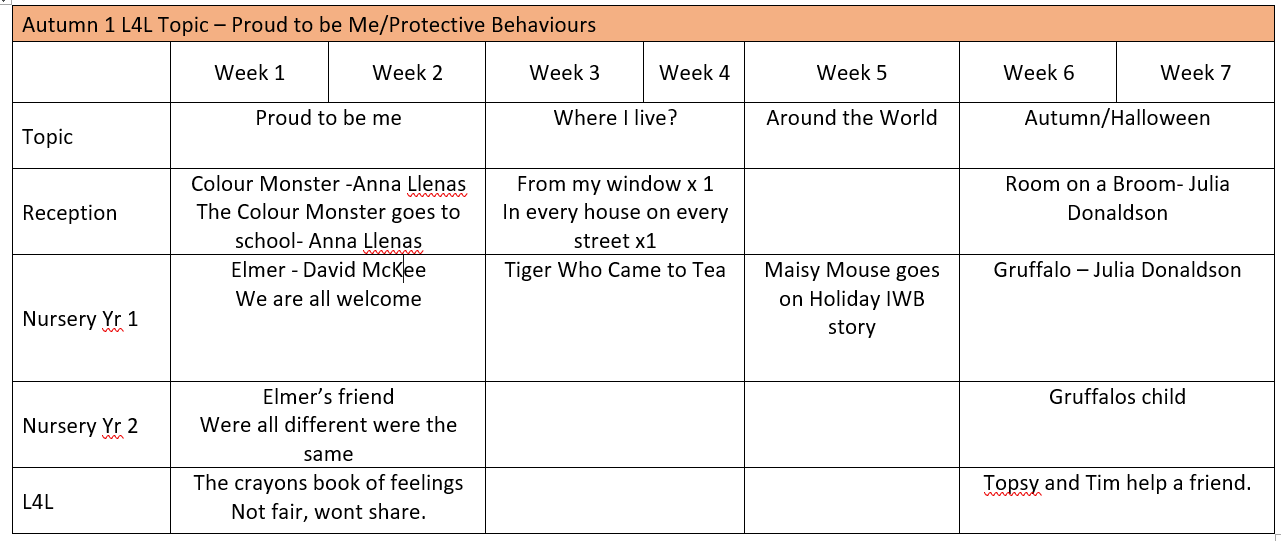
Following from this, the Long Term Plan details the progression in skills across each half-term for Literacy, working towards the appropriate age related expectations for the end of Nursery and Reception. The document also outlines the key texts driving Talk for Writing as well as the focus Nursery Rhyme each half-term. See extracts from Reception 22-23 LTP below.

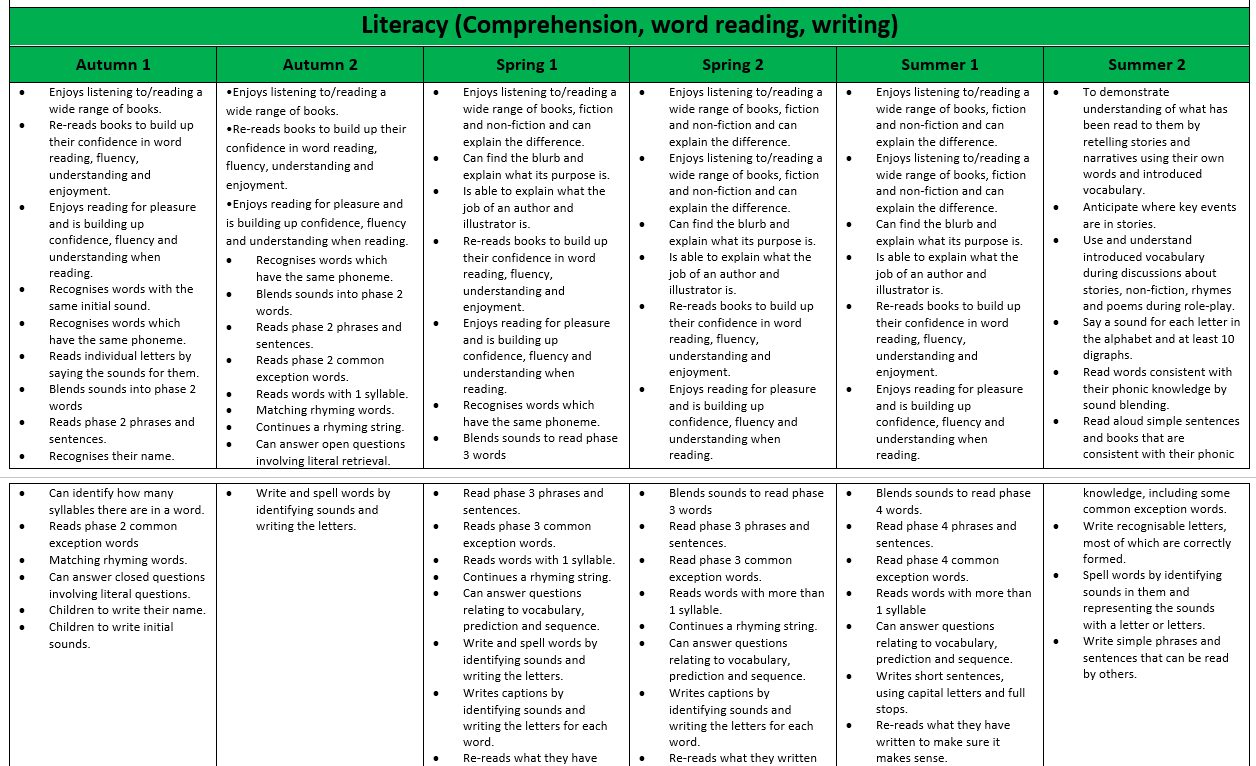
For each topic, teachers create a MTP topic plan. This document shows the links between the different areas of learning and the opportunities that children will receive within the classroom. For Literacy, this details example activities and outcomes as well as focus skills that will be taught.
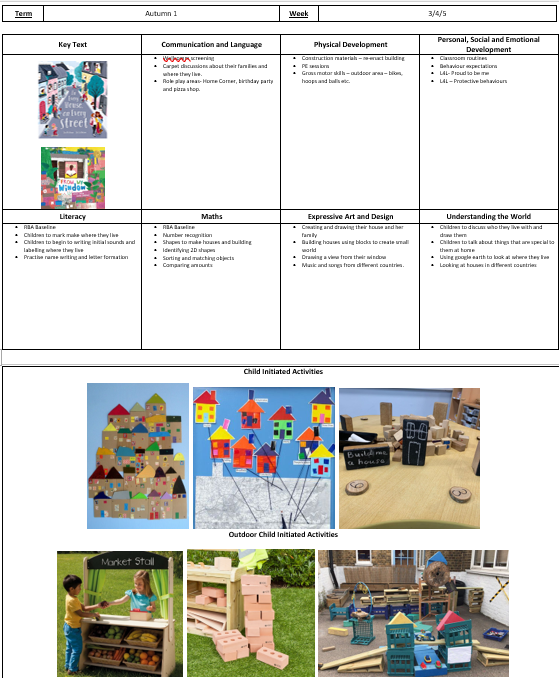
Each week, teachers write a weekly English plan. This plan clearly identifies the focus pupils and groups within the lesson, the role of the LSS, teacher modelling and input (including TM collaborative techniques) and the desired outcomes.
Outcomes:
In Nursery, Writing outcomes are evidence in CI books. Evidence may include mark making, name writing, drawing and initial sounds. Wow moments are blogged on Tapestry for parents/carers to view.
In the Nursery classroom, there is a Phonics wall and a Literacy wall. The phonics wall contains images linked to Phase 1 sounds. The Literacy wall provides an opportunity to showcase pupils writing outcomes in the classroom.
In Reception, Writing outcomes are evidenced in Guided Writing books 3 times per week. In addition, evidence of Writing produced during CI time are evidenced in pupils’ CI writing books. The aim is for each child to have one piece of CI evidence added to their books each week. As in Nursery, Wow moments are added to tapestry to share with parents/carers.
In the Reception classroom, there is a phonics wall and a Literacy wall. The Phonics wall contains the appropriate graphemes as per the Little Wandle scheme. The Literacy wall provides an opportunity to showcase pupils writing outcomes in the classroom.
Assessment:
In Early Years, assessments for Literacy are completed in line with whole school data deadlines, with the exception of the statutory RBAs in Reception, which are completed in line with national deadline. Whilst completing RBAs, teachers also use the information collected during tasks to complete our own internal baselines. This data is used to track progress across the year. From this, we complete initial ELG target setting, which is updated at each assessment point throughout the year.
Regular moderation meetings are held to ensure consistent and fair judgements are made in relation to a child’s progress and attainment.
Assessment informaiton is also gather for letter formation and pencil grips (see handwriting section of this policy).
The HubThe Hub is our school ASD provision, which supports those pupils awaiting a place within a specialist provision. The Hub provision is set to mirror an Early Years environment, with high focus on mark marking and phase 1 phonics.
Where appropriate, pupils access Literacy within other areas of the school, including small group, highly differentiated input and integartion with their peers in the main classroom environment.
Time for Rhyme, bucket time, story time and sensory activities supporting the development of gross and fine motor skills are the main basis of the Literacy provision within the Hub.
Within the Hub, pupils are assessed using the Engagegment profile where they are working significantly below the National Curriculum (or Early Years Statutory Framework) requirements.
Genre knowledge organisers
For each genre there is a knowledge organiser. These outline the purpose of a genre, its key features and the progressive steps when teaching the genre across school.
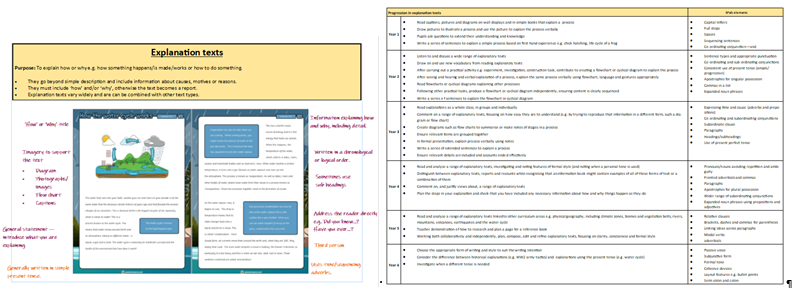
GPS - Grammar Puctuation and Spelling
GPS skills are taught as part of the overall English learning journey, as outlined above, and the high-quality texts provide examples of higher-level punctuation and grammar use for effect.
Each outcome in the English book must have a clear date and LI (learning Intention).
If the learning intention for the lesson in linked to a GPS skill then the learning intention will be GPSLI:
We are always looking for taught skills to impact on the overall quality of children’s writing, so they are always age-appropriate and relevant to the extended writing outcome at the end of each learning journey. Our genre knowledge organisers identify the relevant GPS skills that may be taught during the learning journey (see above).
We also use GPS knowledge organisers. These outline the skills and knowledge required for each year group and provides examples.
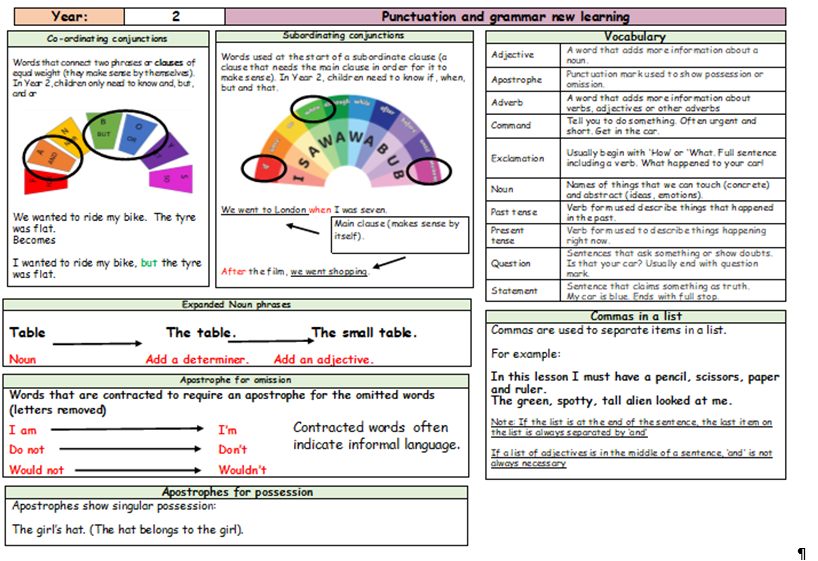
Talk and thought books in Y3-6
Years 3 -6 use Talk and Thought books to encourage children to apply a range of KS2 skills in the National curriculum including making notes, drafting their writing, revising and editing and proofreading their own and others writing. Pupils use red pens to evidence proofreading.
Talk and Thought books are not always marked by the class teacher, although teachers may add comments if they are supporting a child with the proofreading and editing stage of their drafting process.
Pupils use red pens to evidence proof reading in their Talk and Thought books or when proof reading an piece of extended writing on yellow paper.
Vocabulary, including word of the week
In Years 1-6 each week in English there is a new Word of the Week. This is to encourage pupils to develop a wider vocabulary. To teach this word we follow the STAR approach:
S – source an appropriate word
T – teach the word
A – apply in different contexts
R – review continuously throughout the week
Words are sourced from a carefully chosen list of ambitious words for each year group, called Wizard Words (S:\Curriculum design 2022-23\English\Vocabulary). These are mapped into the English Medium Term Plans, where teachers select one word that links in the with the genre that they will be teaching that week so as to allow pupils to apply it independently in their outcomes.
On a Monday, the word is shared with the class. This is then written on the golden star on the learning wall. The word of the week is also displayed on/next to the classroom door on a fluorescent star.
Each week, the old words are removed from the door poster and put around the learning wall so that children can refer back to them throughout the year.
At the start of each lesson, the word of the week is recapped in different ways and contexts, to provide multiple exposures and consolidation of understanding. Activities include speed writing, oral rehearsal, word in a sentence, role play/actions etc.
As well as word of the week, if a pupil uses a WOW word (not technical vocabulary) which is above the expectation for their age, they are awarded a wow wizard sticker. This can either be worn by the pupil or put into their book, depending on their preference. Dojo Praise points may also be rewarded
Spelling
At Temple Meadow Spelling skills in Years 2-6 are taught explicitly using a very clear weekly structure.
|
Monday |
Common exception word lesson (see appendixes in NC) Pupils explore etymology and morphology of words as well as practising techniques to support spelling |
Evidenced in English book |
|
Tuesday |
Teach and practise The focus rule(s) is introduced and explored.Pupils practise the spelling the words in various ways. |
1 outcome evidence in English book |
|
Wednesday |
||
|
Thursday |
Apply and assess The focus rule(s) is recapped. Pupils apply their learning, using the focus words in context. Teachers’ assess pupils’ knowledge and understanding of their learning. |
1 outcome evidence in English book |
|
Friday |
The weekly planning is integrated within the weekly English planning.
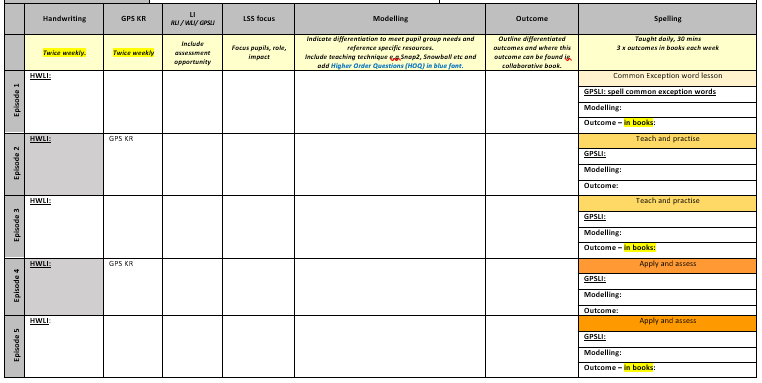
Year 1:
Children that are secure in Phase 5 phonics receive daily spelling lessons in line with the above structure; however, outcomes are kept in pupil folders rather than English books due to pupils mixing across both classes. Spelling only begins in Year 1 once children are secure at Phase 5; this tends to be the Spring term. We track coverage carefully to ensure that we deliver the full breadth of the National Curriculum.
Spelling MTPs
Spelling has been mapped out across each year group and each term. This is integrated into the English MTP. We have carefully mapped out coverage to ensure the full breadth of the National Curriculum as well as opportunities to revisit and retrieve prior learning.
Feedback and marking
Incorrect spellings are highlighted within children’s written work across the curriculum.
Pink highlighter is used to identify something that is wrong – incorrect spellings or missing/incorrect punctuation, grammatical errors, etc. Missing/incorrect punctuation should be highlighted and corrections made by the adult marking.
In a piece of work, incorrect spellings identified are those words which a child is expected to spell correctly based on their current phonics/spelling ability. A limit is placed on the number of words that are identified in a single piece of work:
- Year 1 – 1 word
- Year 2 – 1-2 words
- Years 3 and 4 – 2-3 words
- Years 5 and 6 – 3-5 words
Teacher judgement is to be used in regards to SEND pupils.
A spelling that is wrong is highlighted using the pink highlighter. The correct spelling is then written at the end of the piece of work to demonstrate the correct spelling. The pupil then practises the spelling 3 times in their book.
Corrections are then marked by the teacher, with further inaccuracies in spelling being corrected for the child.
Handwriting
Pupils should be taught to:
- use the diagonal and horizontal strokes that are needed to join letters and understand which letters, when adjacent to one another, are best left unjoined
- increase the legibility, consistency and quality of their handwriting [for example, by ensuring that the downstrokes of letters are parallel and equidistant; that lines of writing are spaced sufficiently so that the ascenders and descenders of letters do not touch].
The quality of the content of a piece of work is sometimes wrongly judged on the neatness of the writing; however, the ability to write legibly and appropriately is a skill without which children will not be able to reach their full potential. If a child is unable to form their letters correctly, and later join their writing in a legible style, it will slow down their thinking when writing. Equally, if the presentation of their work is poor, children are less likely to care about the quality of the content, too.
At Temple Meadow, we believe that pupils must have a secure knowledge of letter formation before they can start to join their letters. Our fonts and handwriting styles progress from basic print (sassoon) to pre-cursive to cursive, as below. To embed this, the fonts in the grid as used in the classroom whenever the child sees printed text (e.g. worksheets, displays, teacher handwriting).
In Nursery and The Hub handwriting is taught using the dough disco scheme and rehearsed through CI play and marking making opportunities, including a range of gross and fine motor sensory activities such as glitter, sand, chalk, paint bags, foam etc.
In Reception, handwriting is taught daily within the Phonics lesson, following the Little Wandle Phonics scheme. The mnemonics are used to help pupils learn the correct letter formation and these are displayed within the classroom environment. Handwriting is also taught in one discrete slot each week, where a range of sensory activities are used to support pupils’ letter formation and handwriting.
In Year 1, Handwriting is taught daily for 10-15 minutes each day. This is done a sensory and hands-on approach until children are secure enough with letter formation to evidence in English books twice per week. This is a transitional porcess. In Years 2 – 6, handwriting is taught twice weekly within the English lesson and evidenced in English books.
|
Year group |
Handwriting taught |
Prerequisites |
|
Nursery and The Hub provision |
Dough disco |
Wide range of gross and fine motor activities. |
|
Reception |
Little Wandle mnemonics and formation |
Little Wandle mnemonics on display Fine motor activities within the classroom environment for children to access during CI play. |
|
Year 1 |
Little Wandle mnemonics and formation |
Little Wandle mnemonics on display |
|
Year 2 |
Pre-cursive formation |
Children must be secure with basic letter formation before being expected to form letters in the pre-cursive style. |
|
Year 3 and 4 |
Letter joins moving to spelling through handwriting |
Children must be secure with basic letter formation before being expected to form letters in the pre-cursive style. Some pupils may need basic letter formation practise still. Children must be secure with pre-cursive letter formation before being expected to join. |
|
Year 5 and 6 |
Joined handwriting linked to spelling words |
Children must be secure with basic letter formation before being expected to form letters in the pre-cursive style. Some pupils may need basic letter formation practise still. Children must be secure with pre-cursive letter formation before being expected to join. |
Example handwriting outcome in KS2:
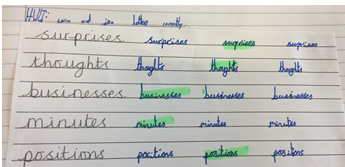
Assessment:
Letter formation trackers and pencil grip assessments are completed for all pupils who have not achieved a pen licence. There are 2 different letter formation trackers – initial letter formation and pre-cursive letter formation.
These are stuck in the back of English books. When the class teacher is confident that the child is able to form a letter securely (this means starting and ending in the correct place, sitting the letter on the line and of the correct orientation) then the letter is dated on the tracker. When pupils have completed a tracker (they have secured the letter formation for all 26 letters) they are awarded a certificate by the Writing Lead. The next tracker is then started and the same process applies. When the pre-cursive tracker is completed, a pen licence is awarded.
Pencil grips are assessed on a half-termly basis in line with the school’s assessment calendar. A pen licence will not be awarded until the child has secured the correct pencil grip.
In school, we have a range of pencil grips and strategies that we use to support the development of the correct pencil grip.
Marking:
Letter reversals are highlighted yellow and the correct formation modelled at the end of the work. A yellow letter should also be provided for the pupil to trace before practising themselves.
A b/d reversal sticker prompts can then be stuck on the top of the next page as a visual reminder. The master template can be found on the Sdrive, curriculum 22-23, English folder.
Handwriting outcomes are marked in line with our feedback and marking policy as below.
Pen Licence:
A Pen Licence is issued when a child’s cursive handwriting meets the following criteria:
- All letters are formed correctly – size, orientation, position on the line.
- Handwriting must be joined.
- Handwriting must be legible.
More specifically:
- There should be clear, consistent sizing of ascenders (to the line above) and descenders (to the middle of line below).
- There should be clear, consistent sizing of upper case (to the line above) and lower case (halfway to the line above) letters.
- Joins should be formed in the following way, with capital letters and the letters o, r, v, w and x being break letters, with no joins:
All letters are joined from the bottom of the preceding letter, with the descenders f, g, j and y looping up from the line below to meet the next letter. The letter q joins from the descender, without looping, and the letter p joins on the line, like other lowercase joining letters.
When children receive their Pen Licence, they can use their pen in all curriculum areas except Maths. All children are eligible to attain a pen licence, which will be awarded to them in assembly. Their school pen will then be given to them by the English lead. It is important that teachers ensure that children maintain their handwriting style and overall presentation once they have a pen licence. When a child is awarded a Pen Licence, this is recorded on SIMs to support transition.
For those children who already have a pen licence, they use the opportunity to practise handwriting but also combine this with rehearsal of common exception words for their year group (see spelling section).
Reading curriculum
As outlined in the previous section, reading skills opportunities are identified and planned as part of the MTP process. Weekly reading opportunities are included within the weekly English planning.
Each outcome in the English book must have a clear date and LI (learning Intention).
If the learning intention for the lesson is linked to a Reading skill then the learning intention will be RLI:
Reading in taught using a wide variety of strategies to best meet the needs of the National Curriculum. Some of the strategies we use to unpick a text include:
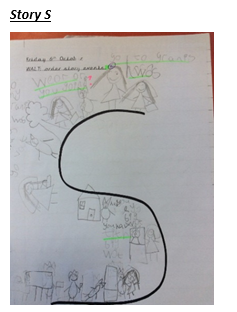
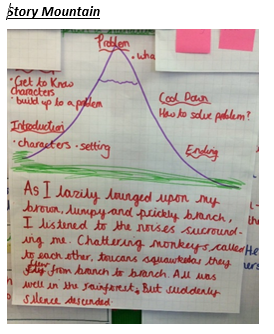
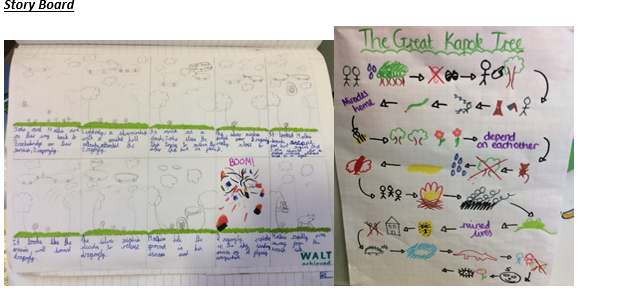
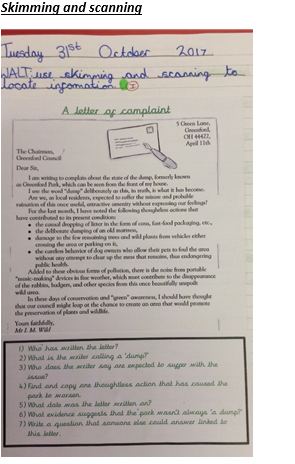
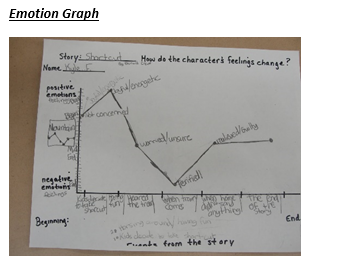
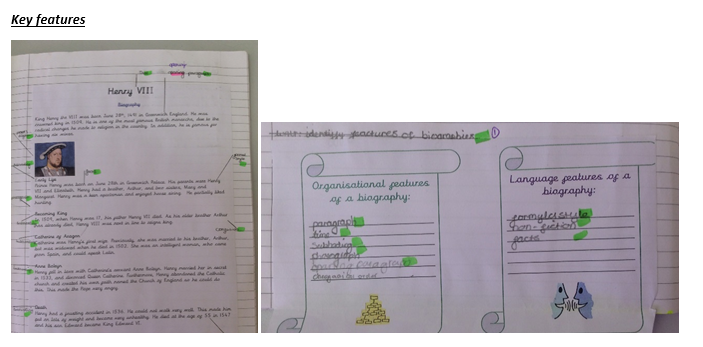
Freeze Frames – exploring characters further through role play
Visualisation - Draw a picture/ diagram to represent the information you have just read. Children can label elements with evidence/ literal retrieval from text or using inference e.g I have coloured the sky black as it suggested in the text that a storm was brewing and I know that just before it rains cloud appear dark (text to self).
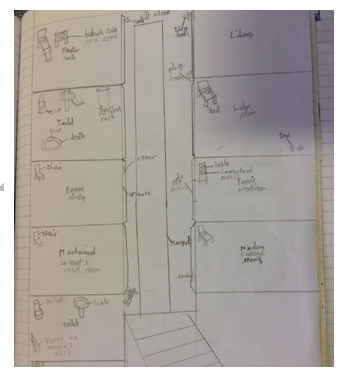
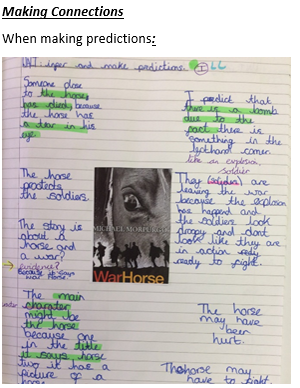
Text to Text-
How do the ideas in this text remind you of another text (story, book, movie, song, etc)? Complete one of the following statements:
What I just read reminds me of … (story/book/movie/song) because…
The ideas in this text are similar to the ideas in… because…
The ideas in this text are different than the ideas in…. because…
Text to Self
How do the ideas in this text relate to your own life, ideas, and experiences? Complete one of the following statements:
What I just read reminds me of the time when I…
I agree with/understand what I just read because in my own life…
I don’t agree with what I just read because in my own life…
Text to World
How do the ideas in this text reading relate to the larger world—past, present and future. Complete one of the following statements:
What I just read makes me think about… (event from the past) because…
What I just read makes me think about… (event from today related to my own community, nation or world) because…
What I just read makes me wonder about the future because…
What do we know for certain?
|
What do we know for certain? |
How do you know? |
What do you think might be happening? |
What clues are you picking up? |
|
|
||
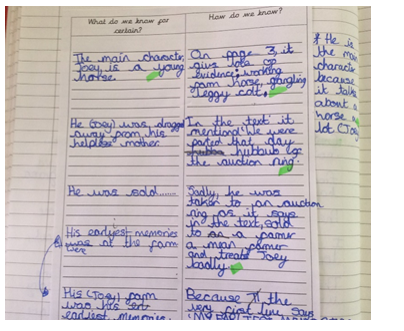
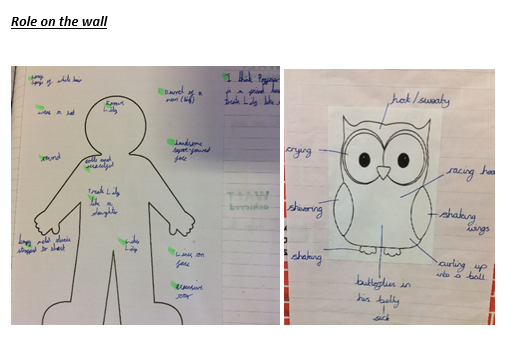
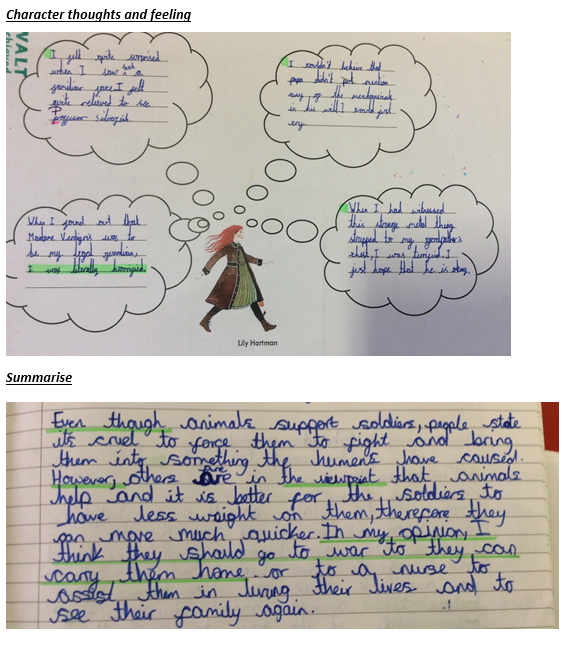
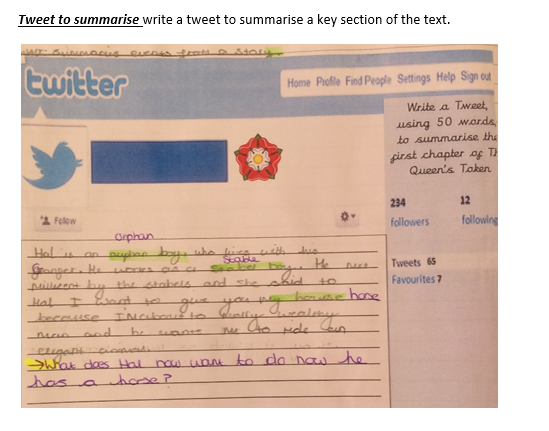
Explicit Reading lessons Y1-Y5
Across years 1-5, children receive 3 x 30 minute Reading lessons each week. Each set of 3 lessons is focused on one of the reading domains relevant to the key stage.
Key Stage 1 reading domains:

Key stage 2 reading domains:
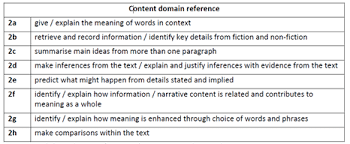
Weekly reading sessions follow the same structure in both KS1 and KS2: decoding/fluency, practise and application. The same text is used for all 3 sessions. Pupils are exposed to fiction, non-fiction and poetry texts based a wide range of topics and themes.The same text is used in all three session, allowing pupils to become over familiar with the text and therefore allow pupils to secure and consolidate comprehension skills.
Decoding and fluency sessions use a range of strategies to develop pupils’ accuracy and speed when reading, in turn developing their confidence. In these sessions, pupils work in mixed ability pairs to allow for peer support when decoding unfamiliar words. Practise and application sessions focus on comprehension skills. Comprehension is the act of understanding what you are reading and is an intentional, interactive process that occurs before, during and after a person reads a particular piece of writing. There are two key elements to comprehension: vocabulary knowledge and text comprehension. In order to understand a text, the reader must be able to comprehend the vocabulary used in the piece of writing. If the individual words don’t make sense then the overall story will not either.
Practise sessions allow pupils to work with a peer to answer focus questions. During the application session, pupils answer questions independently. In years 2-5 these outcomes are recorded in individual comprehension books. In Year 1, outcomes are practical and whiteboard based, with a focus on verbal comprehension skills.
Y6 Reading comprehension
Although much of the Reading National Curriculum is covered through our English Learning journey, we also teach a distinct comprehension session each week in Year 6 in order to prepare pupils for the end of KS2 SATs. The intention is that the 3 part reading approach ensures pupils enter Year 6 as fluent, confident readers and therefore the focus of the Year 6 reading session is securing comprehension skills and test technique.
Comprehension Question Types:
|
Find and copy |
Literal retrieval
Infer and deduce
Summarising
Language and vocabulary
|
|
Multiple choice |
Literal retrieval
Infer and deduce
Summarising
Language and vocabulary
|
|
Complete a table
|
Literal retrieval
Infer and deduce
Summarising
Language and vocabulary
|
|
Matching
|
Literal retrieval
Infer and deduce
Summarising
Language and vocabulary
|
|
Sequencing/ordering
|
Literal retrieval
Summarising
|
|
Explaining
|
Infer and deduce
Language and vocabulary
|
|
Giving evidence
|
Infer and deduce
Language and vocabulary
|
Reading Fluency
At Temple Meadow Primary School, we recognise the importance of fluency as a tool to master before children can be successful with comprehension skills. This is a key component of our Reading approach in Years 1-5. Other opportunities for fluency are through the Reading for Life time table slots. Teachers ensure that reading activities focus on developing fluency skills so that children have:
- Accurate and effortless decoding skills
- Age-level-appropriate reading rates
- Appropriate use of volume, pitch, juncture, and stress
- Appropriate use of text phrasing or “chunking,” leading to comprehension of what you are reading.
Guided practise/echo reading
- Choose a short section from a story and read it aloud while the child listens and follows along. Then read just the first line of the piece and ask the child to read it back to you. Read the second line of the piece and ask the child to read it back to you. Continue until you have completed the piece. Repeat several times.
Repeated reading
- Choose a short book or passage of a book that is just a little above the child’s reading level. Ask the child to start reading. If the child doesn’t read a word correctly, or hesitates for longer than five seconds, read the word out loud and ask the child to repeat it. They should then continue reading. After you complete the entire reading, ask them to read it again three or four times over.
Choral reading
- With choral reading the teacher reads a text several times until children are familiar with it. Then the class joins them as they read the text together. Nursery rhymes, songs, and funny poems are fantastic for choral reading.
Timed reading
- Challenge pupils to see how far they can read within a text in a given time e.g. one minute. Ask them to count how many words they read. Set the timer again and challenge children to read more words this time. Repeat several times.
Stop start reading
- The teacher reads the text with children following along in their own copies. Whenever the teacher stops, the children read aloud the next word in the text. This ensures that children are following the text accurately. The teacher can choose focus words to pause at e.g. focus suffixes, polysyllabic words, new vocabulary etc.
Change your voice
- Children read out loud the text in a given voice. This could be linked to volume (whisper, shout), style (like a robot, like a baby, a posh voice, a deep voice etc or in a given emotion e.g. excited, scared.
Practise sight words using fun activities
- When our children know many words by sight, they’re less likely to be awkward, choppy readers. Sight words are words we want our children to know automatically by sight because they occur so frequently in their reading and writing.
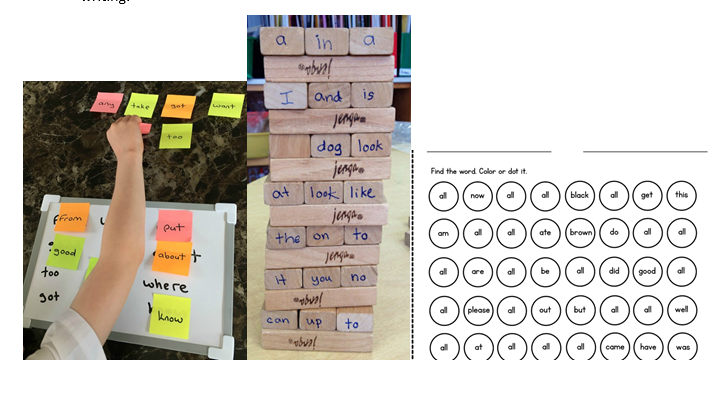
Year 2 decoding evidence
In Year 2, additional decoding evidence is gathered to support teacher assessment against the Reading TAF. Record sheets and complete by the class teacher and/or LSPs and are kept in the Reading folder.
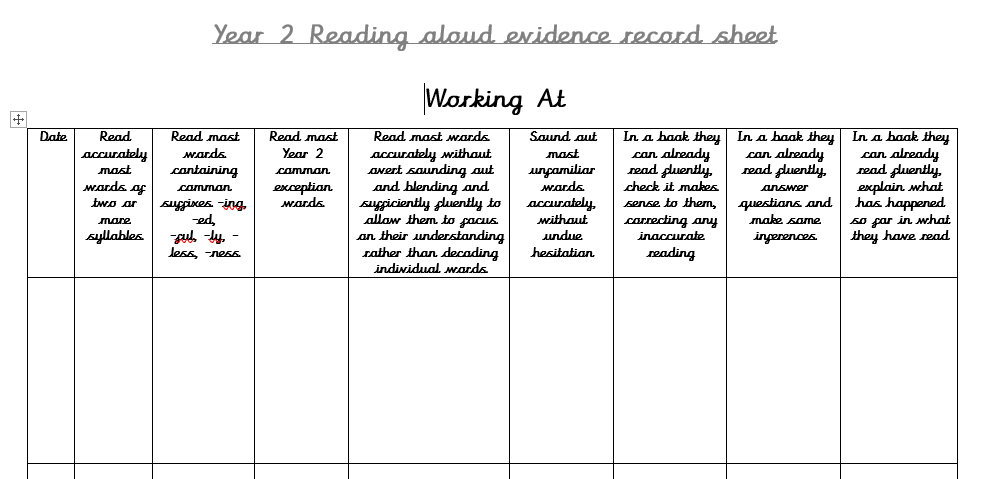
Year 1- Year 5 Collaborative English books
Collaborative books are used to capture examples of work that has been collaboratively by more than one individual. There will still be a clear Learning Intention and assessment of achievement for each individual pupil.
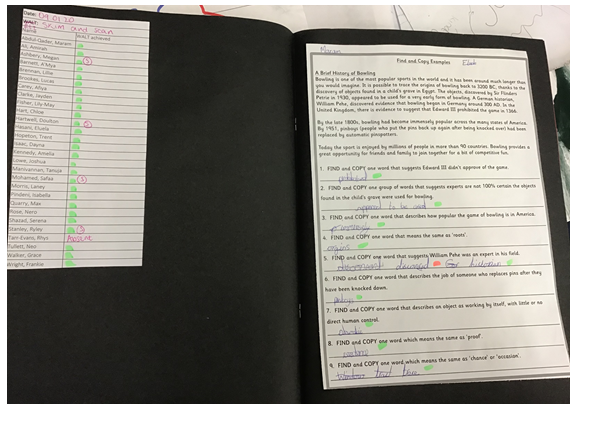
Timetabling
We currently run 10-day time timetables across Years 1-6. English lessons are timetabled daily across days 1-9. In some year groups, English is also timetabled on day 10; this is dependent on cohort needs and is adaptable to meet priorities.
In Years 1-5, Reading is timetabled for 3 x 30 minute sessions each week.
In Year 6, Reading is timetabled for 1 x one hour session each week.
In Years 2-6, spelling is timetabled daily for 30 minute sessions each day.
Learning Walls and enabling learning environments
Teachers use live learning walls to display relevant modelling, use of key vocabulary and examples of outcomes. Children are actively encouraged to engage with this resource when working through an English learning journey.
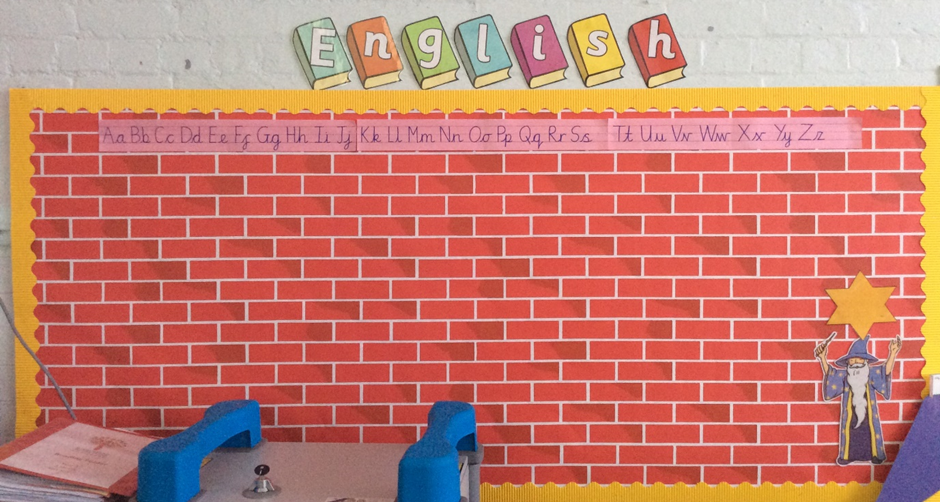
Vocabulary
In Years 1-6 each week in English there is a new Word of the Week. This is to encourage pupils to develop a wider vocabulary. To teach this word we follow the STAR approach:
S – source an appropriate word
T – teach the word
A – apply in different contexts
R – review continuously throughout the week
Words are sourced from a carefully chosen list of ambitious words for each year group, called Wizard Words (S:\Curriculum design 2020-21\English\21-22\Vocabulary). These are mapped into the English Medium Term Plans, where teachers select one word that links in the with the genre that they will be teaching that week so as to allow pupils to apply it independently in their outcomes.
On a Monday, the word is shared with the class. This is then written on the golden star on the learning wall. The word of the week is also displayed on/next to the classroom door on a fluorescent star.
Each week, the old words are removed from the door poster and put around the learning wall so that children can refer back to them throughout the year.
At the start of each lesson, the word of the week is recapped in different ways and contexts, to provide multiple exposures and consolidation of understanding. Activities include speed writing, oral rehearsal, word in a sentence, role play/actions etc.
As well as word of the week, if a pupil uses a WOW word (not technical vocabulary) which is above the expectation for their age, they are awarded a wow wizard sticker. This can either be worn by the pupil or put into their book, depending on their preference. House points may also be rewarded.
Resources
We use a wide range of resources to support and enhance the English curriculum. We also have a bank of teacher resources to support with CPD and planning, including the grammarsaurus non-fiction writing books, comprehension books for each year group and a range of online tools such as a Literacy shed and Twinkl.
Teachers are encouraged to use a range of visual literacy tools, such as imagery and video clips to enhance teaching and learning.
Each classroom from Y2-Y6 have a bank of age appropriate physical dictionaries and thesauruses for pupil use, as well as access to iPads to use online versions of these tools.
Pupils in Early Years and KS1 have access to a specific handwriting and spelling app – Word Wiard.
Resources such as talking tins, dictation tools, pencil grips and adapted writing instruments, coloured paper and overlays are used where required to meet pupils’ individual educational needs.
Inclusion
Inclusion is vital across the curriculum but particularly through our English curriculum. Children are taught English in mixed ability classes. We have high expectations of all children to achieve their very best, at their own pace and learning level. Teachers must skilfully differentiate access to key texts and consider the scaffolding required for each pupil to achieve their next steps within our assessment system. All learning must always meet the needs of all pupils.
Making connections to other subjects
English writing and reading are essential skills for accessing and success in all curriculum areas.
Assessment
Assessment is an ongoing process in English. Children receive verbal and written feedback (in line with our marking and presentation policy) in every lesson to allow them to make good progress. Children are encouraged to make judgements about how they can improve their own work and that of their peers based how successfully they have met the Learning Intention set for the lesson. Learning Intentions link to the statements on the Learning Ladders and are discussed with the children at the start of each lesson, so they are able to assess their own success.
Teachers and learning support gather evidence on children’s progress within the Learning Ladders and this allow us to track their progress, as well as identifying their gaps or next steps in learning. The Learning Ladders are kept ‘live’ by teachers, and are updated regularly, to maintain an accurate picture of progress in English.
Once children have secured an objective within the learning ladders they earn a ticket in the Safe of Success. This is a motivational strategy to encourage children to be fully involved in understanding their own next steps in learning and celebrating their success once achieved. Once per term children in the Safe of Success are entered into a prize draw.
Each strand within the Learning Ladders can be viewed broken down into year groups. This supports teachers with the knowledge of which skills the children will have already acquired and those they are working towards.
The Gap analysis tool is vital to support teachers when planning for individual children next steps.
In Reading, children complete reading age tests, to ensure that they are accessing the most appropriate book, to aid their progress. Please see the R4L T&L policy for full details.
In Year 2 and 6 teachers use the statutory Teacher Assessment Frameworks to gather evidence towards the expected standard in Writing and Reading (Reading Year 2 only).
Teachers have access to exemplification materials to support their judgements.
Enrichment
To build English Capital to support lifelong success as learners and citizens the curriculum at Temple Meadow must be experiential, hands on and imaginative. We value enrichment to support our values. Teachers will often use drama, role play and wider cross curricular links to enrich the English curriculum e.g Green screen technology.
Clubs
At different points during the year there may be opportunities for some children to engage in English focus clubs. These may include Reading, GPS Booster club and writing clubs.
Trips and visits
Each year the trips and visits are mapped out. All of the trips are aimed to provide opportunities that our children may not ordinarily receive e.g. trip to the theatre.
Pupil newsletter
Pupils in KS2 have the opportunity each year to apply to be Writing Curriculum Champions, within which part of the role is contributing to the creating of the school newspaper. Pupils have to complete a job application form and are selected based on these, not on necessarily on their writing attainment.
Each term, pupils work with the English lead to write articles based on events that have taken place within the term. These are then collated into a newspaper and shared with the school community at the end of each term.
Showcase of work
